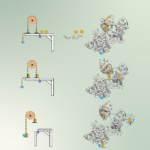A team of Molecular Biophysics and Integrated Bioimaging Division researchers used synchrotron technology unique to the Advanced Light Source (ALS) at Berkeley Lab to probe the conformational states behind electron bifurcation.
Watching the Enzymes that Convert Plant Fiber into Simple Sugars
Researchers in the Berkeley Synchrotron Infrared Structural Biology (BSISB) Imaging Program developed a technique that combines a novel microfluidic device and infrared spectroscopy to study how a cellulose-degrading enzyme works in real time.
Giant Bacteria Genome Yields Clues to How it Meets its Energy Needs
The Biosciences Area’s Nathalie Elisabeth and Jean-Marie Volland collaborated on a study led by researchers from Cornell that produced the first full genome of a species of giant bacteria. Members of the Epulopiscium genus, the largest known heterotrophic bacteria, are a million times larger than E. coli. They live in the guts of tropical marine fish, an environment rich in sodium, which the team’s analysis suggests the bacteria use, along with polysaccharides from their host’s diet, to meet their outsize energy requirements.
Researchers Assess AlphaFold Model Accuracy
An international team of researchers that included developers of the Phenix software suite performed an analysis of AlphaFold predictions, comparing them with both high-quality experimental data and experimentally determined structures. Their results led them to conclude that AI-based protein structure predictions are best considered to be exceptionally useful hypotheses, and that experimental measurements remain essential for confirmation of the details of protein structures.
Nigel Moriarty, Wave Wizard
Experimentation abounds for computational research scientist Nigel Moriarty. A lifelong stamp collector and surfer, Moriarty approaches culturally-distinct pockets of society with the curiosity of an anthropologist. And applying quantum chemistry and theoretical physics to drug design is part of his day-to-day work writing software with MBIB’s PHENIX group.
- « Previous Page
- 1
- 2
- 3
- 4
- …
- 75
- Next Page »
Was this page useful?








